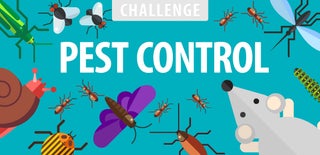Introduction: Ten Ways to Protect Your Organic Garden From Pests
So you have an organic edible garden (you can see my raised bed garden in the picture) and want to protect your vegs from pests without using chemicals, or at least using only organic allowed, low toxicity chemicals.
This instructable will advice you with some of the most environmental friendly ways to control pests
Step 1: Control Aphids With Soap
Aphids are a very annoying pest, they can infest a wide range of vegetables and plants. I had some problem with Arbutus (Arbutus unedo) but also other hedge plants can be infested by this little insect. You don't realize at first because they suck the sap hidden in the back of the leaf
One of the most effective way to get rid of them is sprayng the leaves with a solution of dishwashing soap , about 1 cc in half liter of water, and remove the insects manually. Wear a suitable pair of rubber gloves to do this
After the soap treatment you can use a pyretrum (see further step) solution to definitely kill the remaining aphids
Spraying pyretrum only is not effective because it acts by contact, and it's higly probable that many aphids will not be hit by the solution
Step 2: Pyrethrum
Pyretrum is naturally extracted from Chrysanthemum cinerariifolium and Chrysanthemum coccineum.
Is an effective insecticide but is not very persistent. The extract is commercially avalable, you have to dilute with water and then spry on the plant. Remember that the water solution is not very stable, activity decades in 12 hours expecially if pH is basic. To improve stability I correct the pH with a half spoon of vinegar (for 1 liter solution)
Step 3: Neem Extract
Azadiracta indica is a tree, from which neem is extracted.
Seeds contains various substances that are pretty toxic for coleoptera (beetles) and lepidoptera (butterflyies) and many other. It's not harmful for bees
Grounded seeds are used; make a mixture of 5 kg of seed dust for every 100 l of water and spray directly on plants. Oil extract is also commercially available, follow instructions on bottle for proportions
Step 4: Sulphur
Sulfur is an old remedy and has a good efficacy against a wide range of powdery mildew diseases and black spot.
Is the most important fungicide used in organic production. It is used in organically farmed apple production against the main disease apple scab under colder conditions.
Wettable sulfur is dusting elemental sulfur with hydrophilic characteristics, that can also be conveniently used for applications because i water soluble
Step 5: Bordeaux Mixture
Bordeaux mixture is one of the oldest chemical mixture used since 19th century to control fungine disease. It contains copper sulphate which is the fungicide and calcium hydroxide ( lime), which is mainly added to buffer the strong acidity of the copper salt.
I remeber my father some 40 years ago making this mixtures in a concrete barrel and then spraying with a hand pump the solution over the vine to prevent downy mildew. He dissolved the copper sulphate in the water first, then he added lime until the litmus paper went to green or slightly blue
Use Bordaux mix as fungicige, on a wide range of plant. I use for Arbutus, to prevent fungine disease
Step 6: Snail (or Fly) Trap
These chromotropic traps are very cheap. For snail/slug control screw the yellow cap on a common glass jar.
You have to half fill the jar with an attracting solution, for these pests use some cheap beer,
Dig a hole just near the vegs you have to protect and insert the jar so only the cap section protrude from the ground.
Snails and crawling insect will enter the jar attracted by the beer and never come out.
Replace the content periodically
A bottle cap is used to fight flyies, just use the appropriate attracting solutions
Step 7: Garlic, Chilli and Other Plants
Garlic and onion are active against aphids, mites and flyies. They contains many sulphured compounds that are irritant and toxic to some insects
To make an infusion to use directly on plants or soil, chop 750 g of garlic cloves and suspend in 100 l of water
Step 8: Bacillus Thuringensis
This bacterium contains a protein that is very active against many insects, expecially lepidoptera (butterflyies) and Colorado beetle. It act by ingestion, paralyzing the digestive system
Preparation of the insecticide is obtained in industrial scale, so the formulation is commercially available.
B. Thuringensis is not harmful to bees and other useful insects and also completely harmless to mammals.
Step 9: Ground Rock, Lithotamnion and Minerals
Those mineral substances protect plants from inset attack by forming a phisical barrier that inhibit chewing insects
Ground rock is obtained from various tipes of rocks containing silica. Lithotamion is a obtained from certains calcareous algae and is widely used for example in Brittany (France) as a soil conditioner
Step 10: Propolis
Propolis is a resinous substance that is collected by bees from plants. They mellow the resin with their salivation and bring it to the hive. Its composition is very interesting:
50-55 % resins and balsams (therpenes, polysaccharides, aromatic aldehides, cumarins etc)
25-35 % wax
5-10 % volatile components and essential oils
5 % pollen
5% other organic materials
Propolis enhance immunitary defense also in humans; in agricolture is useful against various cryptogams and aphids. Alcoholic, idroalchoholic or aqueous solutions are used. For the acqueous solution you have to add an emulsifier. This is the recipe:
100-150 g propolis
1 g soy lecithin or egg white
1 l water
The mixture is ready after 2 weeks of aging for spraying directly on plants

Participated in the
Pest Control Challenge












